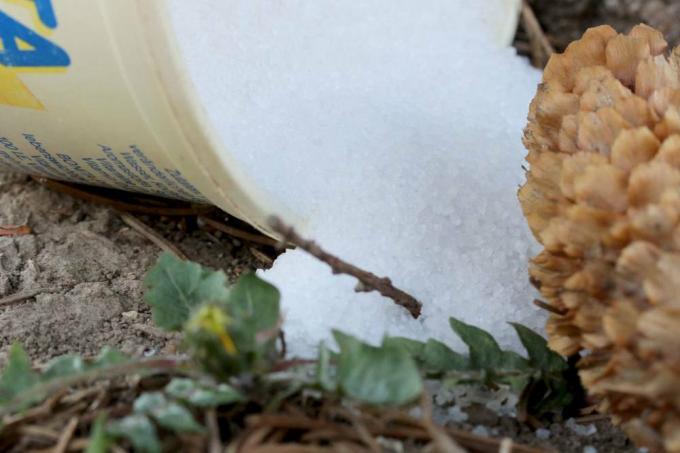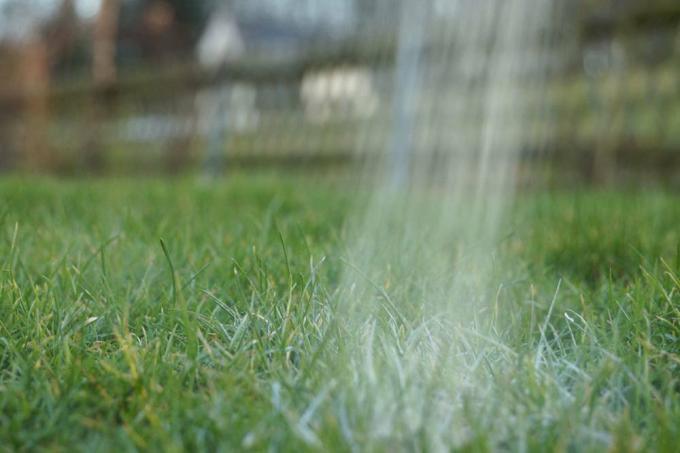
table of contents
- Epsom salt fertilizer
- Epsom salt for sulfur supply
- Soil analysis
- dosage
- Granules or liquid fertilizer
- Suitable plants
- Conifers
- race
- Bog plants
- Vegetables
Epsom salt - a colorless, odorless and water-soluble mineral is known for its various uses. It is used not only in medicine and chemistry, but also in agriculture and horticulture. Now many hobby gardeners swear by the "miracle cure" Epsom salt. However, you should be careful when using it in the home garden. The desired successes do not always come about. However, if used correctly, the plants will benefit from it with healthy growth.
Epsom salt fertilizer
The natural mineral is a magnesium sulfate (MgSO4) and also known as epsomite or epsom salt. Epsom salt contains 15 percent magnesium oxide (MgO) and 30 percent sulfuric anhydride (SO3). Because of this, it is an excellent supplier of magnesium and sulfur, in short a special fertilizer for plants.
Magnesium is a component of the plant pigment chlorophyll (responsible for the leaf green). Plants need magnesium to build up sugar, from which they ultimately produce cellulose and other endogenous substances that are necessary for photosynthesis. Epsom salt is also an important component in various complex fertilizers, the so-called “complete fertilizers”.
In agriculture and horticulture, the mineral is mainly used to compensate for a magnesium deficiency in the soil. At the same time, the pH value of the soil is reduced when it is used. Epsom salt is used as a granulate, but also as a liquid fertilizer, but not all plants tolerate this fertilizer. More on that later.
Note: The salt is also used successfully in medicine, for example in "heat packs" for Generating therapeutic heat or as a laxative, for purification, for strains, sprains and Arthritis.

Epsom salt for sulfur supply
Since Epsom salt also contains a very high proportion of sulfur, it is ideal as a sulfur fertilizer. A lack of sulfur in the soil manifests itself mainly in a similar way to the symptoms of a lack of nitrogen. In most cases, the entire leaf, including the leaf veins, then changes color yellow. However, only young leaves are usually affected.
Regular incorporation of ripe compost or rotted cattle manure can prevent a lack of sulfur in the soil in advance. In addition, the sulfur balance can also be balanced through targeted administration of Epsom salt or other mineral and organic complex fertilizers.
Not all soils tolerate a dose of Epsom salt equally well. Before fertilizing with Epsom salt, the nature of the soil must be known. You can easily determine the pH value yourself using a quick test. However, a detailed soil analysis should be left to a laboratory.
Note: Soil analyzes are carried out, for example, by Agricultural Investigation and Research Institutes (LUFA). Information is available from local environmental agencies. The costs are between 20 and 50 euros, depending on the scope.
Soil analysis
Before fertilizing with Epsom salt, it is important to know the soil conditions. A soil analysis offers protection against over-fertilization with nutrients. Otherwise it can quickly lead to root burns due to an excessive salt content. Ultimately, the plants then dry up. A professional soil analysis provides information about
- Soil pH
- Overview of the existing nutrients such as.
- magnesium
- nitrogen
- potassium
- phosphorus
- copper
- iron
- boron
- at the same time fertilization recommendation is made
Carrying out the soil analysis
At least 500 g of soil should always be taken from a uniformly used garden area, for example a vegetable garden or lawn. The more samples are available, the more reliable the result will be.
- Even removal of 10 to 15 samples over the entire surface
- Mix samples thoroughly in the bucket
- Fill 500 g in a plastic bag
- provided with name, date and garden area
The correct depth from the entire root zone of the plants in question is important when removing. The nutrient deposits that are also reached by the plant roots are important.
- race at least 10 cm
- Vegetable and perennial bed 30 cm
- Fruit and conifers maximum 60 cm

Note: A professional soil analysis provides long-term results for five years. Then a repetition should take place.
dosage
Depending on the nature of the soil and the magnesium value present per 100 g of soil, the following dosage recommendations result:
Light floors
- Water seeps away quickly
- Leaching of an increased proportion of magnesium
- 30 g of salt per square meter with a magnesium value of 1 to 2 mg per 100 g of soil
- 15 g of salt per square meter with a magnesium value of 3 to 5 mg per 100 g of soil
- No administration if the magnesium value is above 5 mg per 100 g of soil
- Fertilize two to three times per season
- first fertilization in June
- Repeat in August
Medium floors
- 30 g of fertilizer per square meter with a magnesium value of 1 to 4 mg per 100 g of soil
- 15 to 20 g of fertilizer per square meter with a magnesium value of 5 to 10 mg per 100 g of soil
- No administration if the magnesium value is higher than 10 mg per 100 g of soil
- Fertilize once a season
Heavy soils
- 30 g of fertilizer per square meter with a magnesium value of 1-8 mg per 100 g of soil
- 15 to 20 g of fertilizer per square meter with a magnesium value of 9 to 13 mg per 100 g of soil
- No administration if the magnesium value is more than 14 mg per 100 g of soil
- Fertilize once a season
Granules or liquid fertilizer
Epsom salt can be applied in liquid form but also as granules. A few things should be considered:
Spray solutions
- Use in case of acute magnesium deficiency
- Dissolve 200 g of salt in 10 liters of water
- never use in sunshine
- then burns
- do not apply before rainy periods
- Spray off plants with a garden hose before use
- alternatively spraying after rain
- cloudy days in April are well suited
granules
- Spring time
- if necessary, repeat in autumn
- sprinkle around plants
- not directly on roots
- some distance from the trunk
- then water well
- Caution: do not wash out the salt completely

Suitable plants
Not all plants tolerate salt fertilization equally well. Therefore, caution is always advised. If used correctly, the special plant fertilizer can then be of great service to the following plants:
Conifers
All Conifers, thuja and cypress trees have a high consumption of magnesium.
- 20 g salt per square meter compensates for a deficit
- Use as granules or for pouring
- with yellow-colored needles application of 2% spray solution
- Spray the underside of the needles and shoots
- Solution preparation Dissolve 200 g of salt in 10 liters of water
Note: If the needles are already colored brown, there is a potassium deficiency. Then the use of special pine fertilizer or potassium sulfate is advisable.
race
Many lawns are undersupplied with nutrients such as potassium or magnesium. Epsom salt fertilization can help.
- Spring time
- Fertilize after the first lawn cut
- 50 g of salt per square meter
- sprinkle well on lawn
- then water
- Ideally suited for days before rain
- prevents weed growth
In Lawn fertilizer mixtures the salt is also included.

Bog plants
rhododendron, Azalea and Erika love an acidic environment to grow. If the pH of the soil is too high, the salt can therefore be used.
- Dissolve 150 g of salt in 10 liters of rainwater
- Pour the soil evenly
- Support photosynthesis
- Stabilization of the chlorophyll content of the leaves
Solution applied to one square meter lowers the pH value by one point.
Vegetables
Heavy eaters such as tomatoes, cucumber, celery, beetroot or spinach have a high magnesium requirement. Deficiency symptoms can quickly arise. A targeted application of the salt fertilizer then ensures an adequate supply of magnesium.
- weekly foliar fertilization
- Use 0.5% saline solution
tip: In the case of leaf spot disease, an improvement in symptoms can also be achieved by spraying an Epsom salt solution in a 2% concentration. In this case, however, nitrogen-based fertilizers must be dispensed with.



